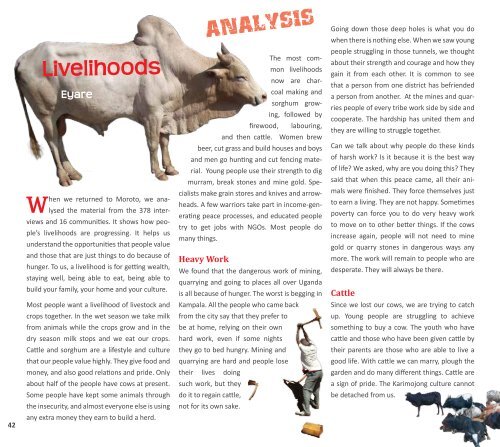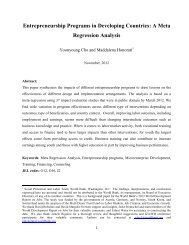Download - Institute of Development Studies
Download - Institute of Development Studies
Download - Institute of Development Studies
- No tags were found...
You also want an ePaper? Increase the reach of your titles
YUMPU automatically turns print PDFs into web optimized ePapers that Google loves.
42LivelihoodsEyareWhen we returned to Moroto, we analysedthe material from the 378 interviewsand 16 communities. It shows how people’slivelihoods are progressing. It helps usunderstand the opportunities that people valueand those that are just things to do because <strong>of</strong>hunger. To us, a livelihood is for getting wealth,staying well, being able to eat, being able tobuild your family, your home and your culture.Most people want a livelihood <strong>of</strong> livestock andcrops together. In the wet season we take milkfrom animals while the crops grow and in thedry season milk stops and we eat our crops.Cattle and sorghum are a lifestyle and culturethat our people value highly. They give food andmoney, and also good relations and pride. Onlyabout half <strong>of</strong> the people have cows at present.Some people have kept some animals throughthe insecurity, and almost everyone else is usingany extra money they earn to build a herd.ANALYSISThe most commonlivelihoodsnow are charcoalmaking andsorghum growing,followed byfirewood, labouring,and then cattle. Women brewbeer, cut grass and build houses and boysand men go hunting and cut fencing material.Young people use their strength to digmurram, break stones and mine gold. Specialistsmake grain stores and knives and arrowheads.A few warriors take part in income-generatingpeace processes, and educated peopletry to get jobs with NGOs. Most people domany things.Heavy WorkWe found that the dangerous work <strong>of</strong> mining,quarrying and going to places all over Ugandais all because <strong>of</strong> hunger. The worst is begging inKampala. All the people who came backfrom the city say that they prefer tobe at home, relying on their ownhard work, even if some nightsthey go to bed hungry. Mining andquarrying are hard and people losetheir lives doingsuch work, but theydo it to regain cattle,not for its own sake.Going down those deep holes is what you dowhen there is nothing else. When we saw youngpeople struggling in those tunnels, we thoughtabout their strength and courage and how theygain it from each other. It is common to seethat a person from one district has befriendeda person from another. At the mines and quarriespeople <strong>of</strong> every tribe work side by side andcooperate. The hardship has united them andthey are willing to struggle together.Can we talk about why people do these kinds<strong>of</strong> harsh work? Is it because it is the best way<strong>of</strong> life? We asked, why are you doing this? Theysaid that when this peace came, all their animalswere finished. They force themselves justto earn a living. They are not happy. Sometimespoverty can force you to do very heavy workto move on to other better things. If the cowsincrease again, people will not need to minegold or quarry stones in dangerous ways anymore. The work will remain to people who aredesperate. They will always be there.CattleSince we lost our cows, we are trying to catchup. Young people are struggling to achievesomething to buy a cow. The youth who havecattle and those who have been given cattle bytheir parents are those who are able to live agood life. With cattle we can marry, plough thegarden and do many different things. Cattle area sign <strong>of</strong> pride. The Karimojong culture cannotbe detached from us.
















